Name Amrapali Amrapali | ||
 | ||
Amrapali the journey from nagar vadhu
Āmrapālī, also known as "Ambapālika" or "Ambapali", was a celebrated Nagarvadhu (royal courtesan) of the republic of Vaishali in ancient India around 500 BC. Following the Buddha's teachings, she became an arahant. She is mentioned in the old Pali texts and Buddhist traditions, particularly in conjunction with the Buddha staying at her mango grove, Ambapali vana, which she later donated to his order and wherein he preached the famous Ambapalika Sutta. The legend of Amrapali originated in the Buddhist Jataka Tales some 1500 years ago.
Contents
- Amrapali the journey from nagar vadhu
- Vyjayanthimalas Dance Face Off Amrapali HD Video Sunil Dutt Shankar Jaikishan
- Early life
- Becoming a Courtesan
- Amrapali and Bimbisara
- Amrapali and the Buddha
- Attitude towards courtesans in scriptures
- In popular culture
- References
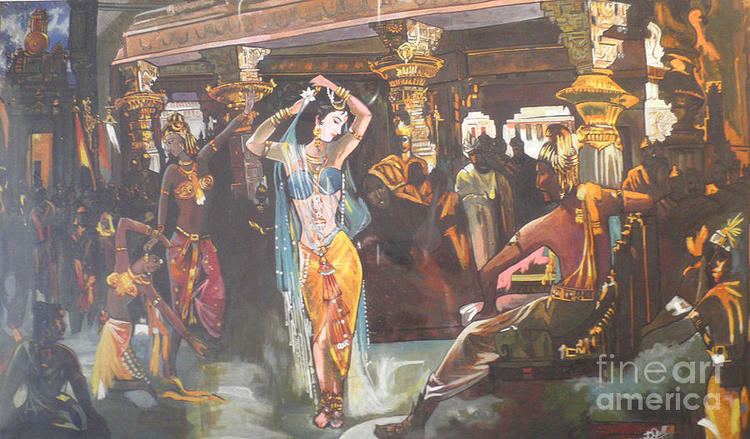
Vyjayanthimala's Dance Face Off | Amrapali | HD Video | Sunil Dutt | Shankar - Jaikishan
Early life
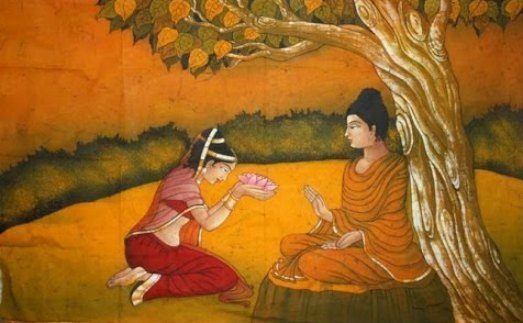
Amrapali or Ambapali was born around 600-500 BC to unknown parentage, and was given her name because at her birth she was said to have been spontaneously born at the foot of a mango tree in one of the royal gardens in Vaishali. Etymologically, the variants on her name derive from a combination of two Sanskrit words: "Amra", meaning mango, and "pallawa", meaning young leaves or sprouts. Even as a young maiden, she was exceptionally beautiful. It is said that a feudal lord by the name of Mahanaman was so lured by her looks that he abandoned his kingdom shifted to Ambara village, a small hamlet in Vaishali.
Becoming a Courtesan
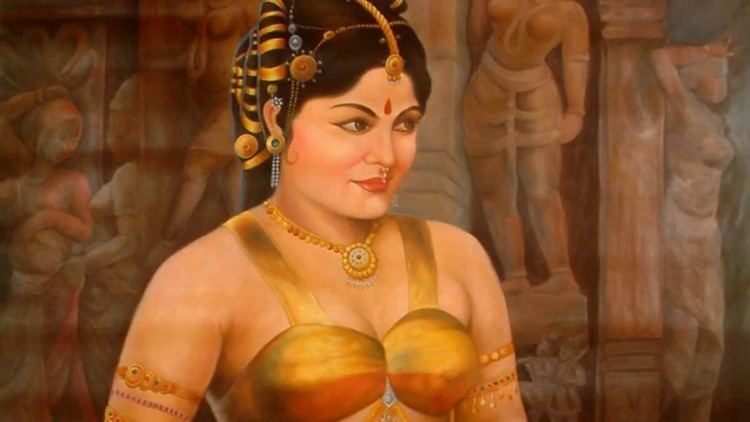
Vaishali was the capital city of the Lichchavi clan, one of the eight Khattiya (Sanskrit, Kshatriya) clans that had united to form the Vajjian confederacy. Here, the King was elected by an electoral college consisting of princes and nobles from the Kshatriya clans. There was a custom in the land that the most perfectly beautiful women were not allowed to be married to one man but had to dedicate themselves to the pleasure of many.
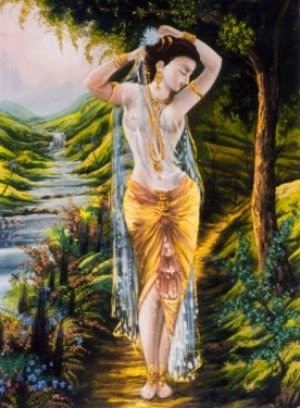
Amrapali grew up to be a lady of extraordinary charm, and grace and was extremely talented in many art forms Many young nobles desired her company. It is said that Manudev, king of Vaishali, saw her dance performance in the city, he planned to 'own' her. He murdered Amrapali's would-be-groom, Pushpakumar (her childhood love) on the day of marriage and made an official announcement declaring her as the 'bride' of Vaishali i.e. the Nagarvadhu. She was also conferred the title 'Vaishali Janpad Kalayani'. Janpad Kalyani was the term given to the most beautiful and talented girl of the kingdom who was selected for a period of seven years, and a palace was given to her. She also had the right to choose her lover but could not be committed to any one man.
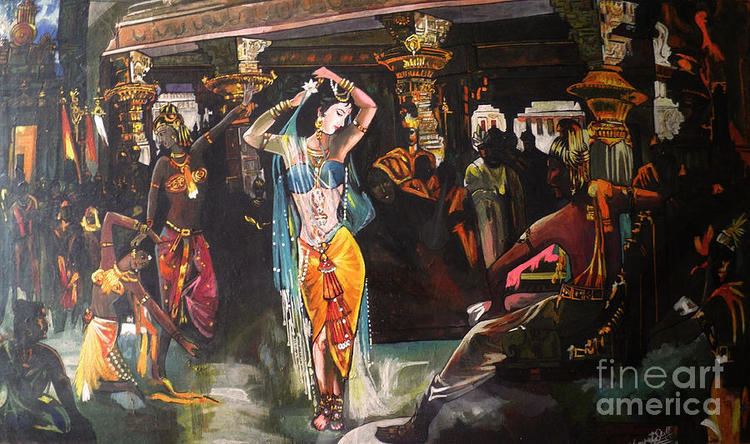
After being conferred the title of nagarvadhu, Amrapali also became the rajanartiki or court dancer. Her talent and beauty attracted a lot of men that the glory of Vaishali in this period is often attributed to Amrapali's fame. Her price was fifty kahapanas per night and her treasury grew much larger than some kings.
Amrapali and Bimbisara
Stories of her beauty travelled to the ears of Bimbisara, king of the hostile neighbouring kingdom of Magadha. He attacked Vaishali, and took refuge in Amrapali's house. Bimbisara was a good musician. Before long, Amrapali and Bimbisara fell in love. When she learned his true identity, Amrapali asked Bimbisara to leave and cease his war. Bimbisara, smitten with love, did as she asked. In the eyes of the people of Vaishali, this incident made him a coward. Later, Amrapali bore him a son named Vimala Kondanna.
Ajatashatru, Bimbisara's son by Queen Chelna (according to Jaina traditions) or Queen Kosala Devi (according to Buddhist traditions), later invaded Vaishali due to a dispute with his brothers. He was so moved by her beauty that when Amrapali was imprisoned, he burned the whole of Vaishali. Almost everyone died in the massacre, except his beloved Amrapali, but when she saw the condition of her motherland, she renounced her love for him.
Amrapali and the Buddha
In Buddhist records, Amrapali is noted as having had the opportunity to serve food to the Buddha during his last visit to Vaishali, shortly before his death. Amrapali attended his sermon at a nearby grove and was so deeply moved by it that she invited him for a meal at her quarters. In other accounts, it is stated that the Buddha himself took shelter in her mango groves and was visited by Amrapali who paid her obeisance to him and then extended the invitation. He consented to her proposal with silence. On her way back, her chariot collided with that of the princely nobles of Vaishali who were also heading to invite the Buddha to dine with them. They berate her by calling her a 'mango-woman' and ask her, a woman of ill repute, to move aside and let her superiors pass. It is then that she announces that the Buddha was coming to her house for a meal. The princes were upset and offered her gold in return of the privilege of hosting the Buddha but she refuses. Buddha also turns them down, having already committed to Amrapali.
Buddha recognised her beauty and advised his disciples to be mindful in her presence lest they become infatuated with her. Amrapali received the Buddha with her retinue in her grand residence which had been specially decorated for the occasion. It was no less than the palace of any king; such was the wealth she commanded. At the conclusion of the meal, she offered to the Buddha and his order her entire property including her groves which became the venue for several sermons on mindfulness. Soon thereafter, she renounced her position as courtesan, accepted the Buddhist way, and remained an active supporter of the Buddhist order. She dedicated her life to the service of the poor and the destitutes.
On growing up, Amrapali's son, Vimala Kondanna also became a Buddhist monk and a renowned elder.
Attitude towards courtesans in scriptures
The story of Amrapali is significant for understanding contemporary attitudes of courtesans. Though she received much fame as a talented artist, she was also berated by the noble princes of Vaishali by calling her 'ganika' (i.e.prostitute) which carried derogatory connotations. However, unlike them, Buddha did not have share that kind of prejudice towards her. He ate at her residence and accepted his grove for the Buddhist order. This is often quoted as an example for his unbiased regard towards women. However, what has been noticed is that with the passage of time and as the Therigatha was collated, this bias also entered the Buddhist fold.
Amrapali's possible alliance with Bimbisara has also survived mainly through an oral tradition and has not found its way into the Pali canon of Buddhism. This is because Bimbisara was a great royal patron of Buddhism and his links with Amrapali may throw a negative light on him. Amrapali's mention in the canon also focuses mostly on the later part of her life when she converted to Buddhism.
However, records of Chinese travellers who came to India in search of Buddhist texts have made note of Amrapali's early life and her relationship with Bimbisara. The latter is found in the Chinese Recension of the Buddhist tripitaka. This narrative has been written in the Mahayana tradition and therefore did not have the onus of representing Bimbisara in a positive light. Hence, their relationship is highlighted.
A third set of scriptures which refer to the story of Amrapali, and do so most elaborately, come from the Gilgit area of Kashmir and are therefore known as the Gilgit Manuscripts. These are the Tibetan-Sanskrit scriptures of the Mulasarvastivada branch of Buddhism which hold her in high esteem. However, the negative connotation of being a courtesan is still present. Thus, the cultural memory of a courtesan shows a complex pattern, varying across time and place.
